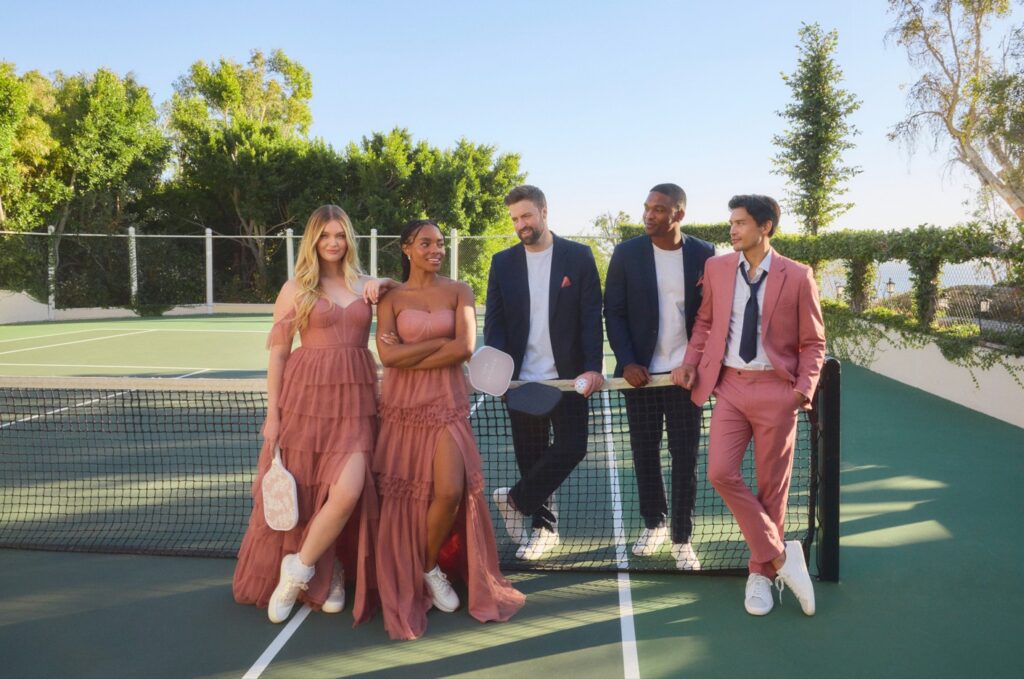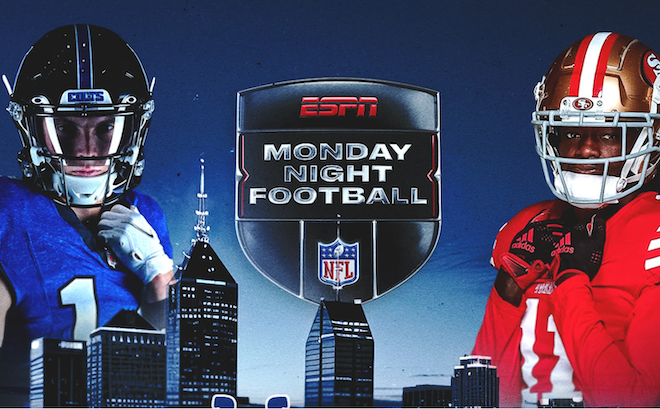Bridesmaid dress retailer Revelry plans to market its new men’s line of suits to the same target customers as it does bridesmaid dresses: the bride. Revelry’s senior director of marketing shares more, plus attribution challenges of tying its marketing campaigns to sales.
Bridesmaid dress retailer Revelry wants to be the go-to destination for brides to outfit their entire bridal party, and that includes groomsmen.
To that end, Revelry just launched a men’s suit line with suits available in 16 colors. Beyond the typical neutral colors, seven of Revelry’s colors match its dresses, including a dusty rose pink and a sage green, said Alena Wells, senior director of marketing at Revelry.
The new product line is in response to shopper feedback from post-purchase surveys, in its website search bar and Facebook group of more than 20,000 brides, Wells said.
“A lot of the times our customers are looking for something for the ‘bridesman,’ if you will, or ‘man of honor,’” Wells said. “That is something that we had been hearing and we’re like, well, why don’t we just create that? We can do that.”

It took about two years to launch the line, which is now ready for its peak season, as 45% of couples get engaged between November and February, according to wedding planning publisher TheKnot.com. Revelry updated its packaging to ship suits in a black box, instead of a pink one with a ribbon, as it does for its bridesmaid dresses.
Marketing the new men’s suit line
While men are the product owner and likely buyer, it’s the bride Revelry will be marketing this product to as she is the one deciding what the bridal party will wear.
“We are still marketing to brides because a lot of the times they’re the one bringing the companies to the groom or the groomsmen being like, ‘We need to look here for your suit,’ or, ‘We need to look here for your groomsmen suits,’” Wells said. “It is kind of an easier shoe in for us for suits because we already have a large customer base, which is the decision maker, which is the bride.”
The best marketing channel for Revelry — or the one that achieves the highest return on ad spend and captures the majority of its investment — is Google.
Google generates high ROAS for Revelry
Revelry spends roughly 50% of its digital marketing budget on Google shopping and Google search ads, and it has between roughly a nine-to-one return on ad spending. Meaning, for every $1 it spends on ads, it receives $9 to $11 back, she said.
Google is so effective for bridesmaid dresses because often brides haven’t extensively researched in this category before. They turn to Google with generic search terms, such as “bridesmaid dresses” to see what’s out there, Wells said.

“Google is where we’re seeing the most return and where we plan to scale the most,” she said.
Revelry plans to turn to this effective channel for suits as well for wedding-specific keywords such as “wedding suits” or “groomsman suits.”
Influencers also are an effective marketing channel for Revelry and the apparel brand is beefing up its content with couples. The new influencer content will still target females, but also showcase how the bridesmaid dresses and suits match.
Marketing attribution woes
One of Revelry’s top challenges is attribution. While the bride decides what the wedding party wears, and is the customer that Revelry wants to acquires, she is likely not the one making the purchase. And so attributing a marketing strategy to a sale is challenging, Wells said.
One of the brand’s top acquisition tactics is sending brides sample swatches of its fabrics. Revelry invests in its packaging and presentation to make this a “wow” moment for the bride, Wells said. This is the most important contact, as it’s the first time Revelry’s product is in the bride’s hands, and when she is likely choosing between several companies. Revelry includes a look book with the fabric samples as well to inspire her on how all of the dresses will look together.

“Then after that is where we start to lose sight of what is happening because that’s when, she’s not really the customer anymore,” Wells said.
Now, the bride is likely sociating feedback from her bridal party, roughly five people, and then deciding. If she does pick Revelry, then shoppers will go onto the site and buy the dress or suit. Revelry asks customers to input the bride’s phone number but not many do. Often, Revelry will not know if a specific swatch sample drove a purchase.
“It is hard, and we haven’t quite figured it out, transparently,” Wells said. “It’s something that we’re actively working toward with systems and just gathering emails and figuring out ways in the cart and orders to be able to connect people together without forcing people to connect each other. It’s a lot of backend work that we’re working towards to be able to do that. But it’s a work in progress.”
Revelry launches digital showroom
One method Revelry is trying is a tool it recently soft launched is a digital showroom. On this page on its website, brides can pick multiple dresses and suits and see how they look next to each other. She can invite her bridal party with a link to view the dresses, which they can after submitting their email address. That helps Revelry tie all of those shoppers together if they do end up purchasing, Wells said.
The brand added the showroom on its site a few weeks ago and has not marketed it yet. About 240 shoppers have created a showroom, which Wells is pleased with.
“We’re hoping next year we’ll be making strides forward in data and really understanding the customer life cycle a little bit more,” she said.
2025 goals and challenges
For 2025, the goal is to have suits generate about 5% of Revelry’s revenue. The brand is forecasting that based on its current sales of men’s accessories, such as ties and pocket squares.
The brand also had plans to relaunch its TikTok advertising strategy in January 2025. The timing is not ideal, in light of the potential U.S. government ban on the popular social media app.
Revelry tested ads on TikTok in Q1 of 2024 and paused it after it didn’t see great performance, she said. It’s planning to start fresh in January 2025, and is continuing to strategize campaigns for the platform, and operating as if the ban will not happen.
“TikTok is great for brand awareness. I don’t necessarily think that it’s going to get us to where we want to be,” Wells said. “I don’t necessarily see it as a huge revenue driving channel.”

If the U.S. government were to ban TikTok, it would not make a large impact on Revelry’s marketing strategy. She believes all of the creators on TikTok would pivot to a different platform.
One of Revelry’s largest challenges heading into the new year is the rising costs of shipping and production coupled with consumers’ expectations of low prices.
“Customers are okay with sacrificing quality to get low prices and get it now,” she said. “Companies are either having to trim their margins to keep up with customer expectations or losing out. And it’s just making it really hard to continuously grow than it was maybe a few years ago.”
Revelry achieved “astronomical” growth during the COVID-19 pandemic, because Revelry allows shoppers to try on products at home before purchasing, Wells said. The brand has “leveled out” from that growth but is now on an upward trend, she said.
“We are expecting to grow a lot next year, but it is something that is making it challenging with just the state of the economy and customer expectations. It’s a constant battle,” she said.




